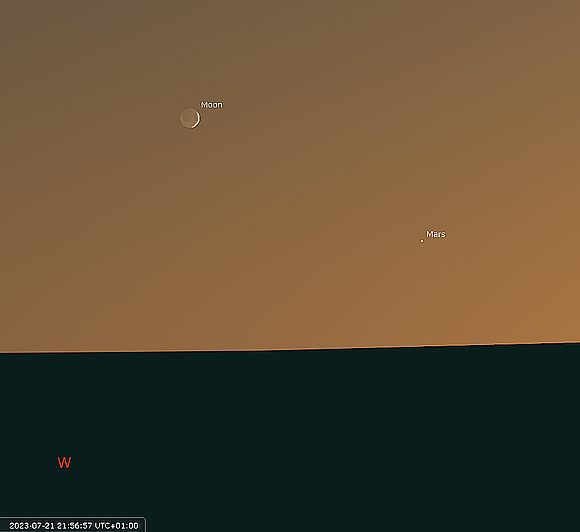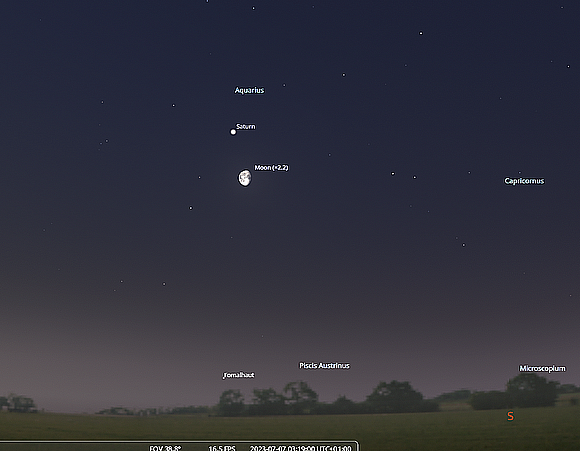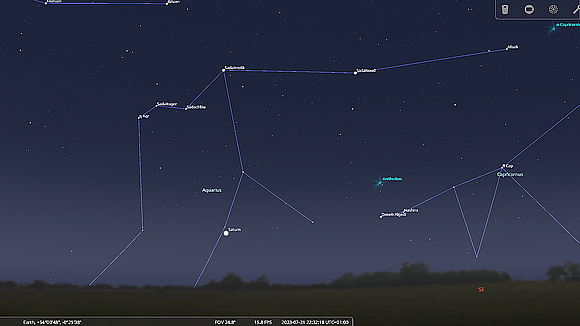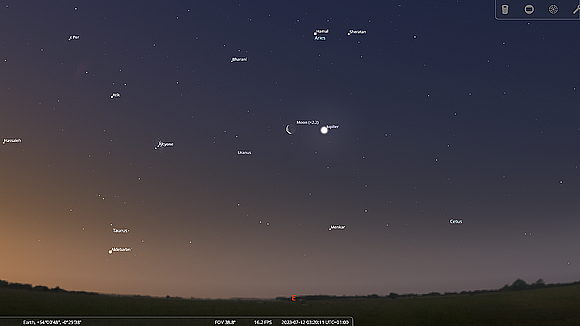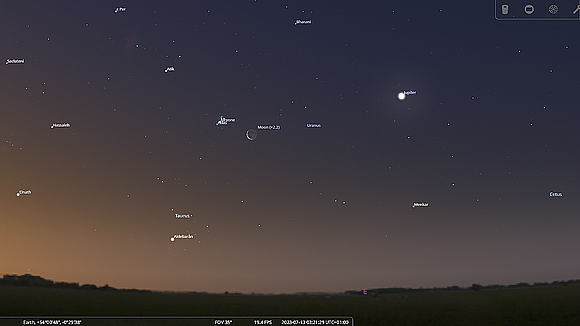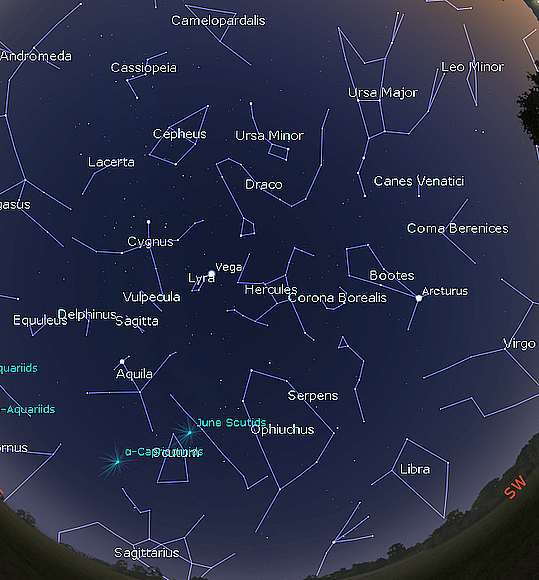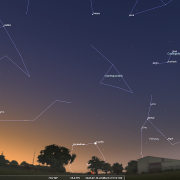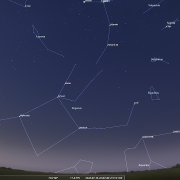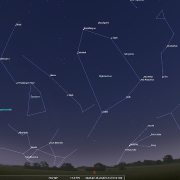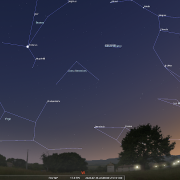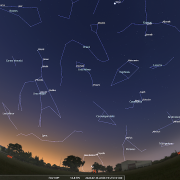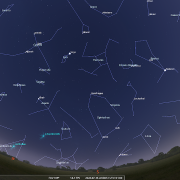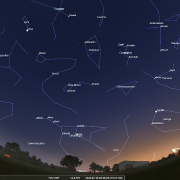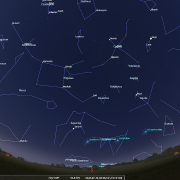In this month's Sky Notes:
Planetary Skylights: A Brief Guide to July's Night Sky
Venus and Mars are finally lost to twilight and the horizon. Jupiter and Saturn rule the early morning sky.
 After almost five months of Venus dominating the evening sky, the 'evening star's' brilliant apparition is finally drawing to close as it drops down to the west horizon by third week of July. View early in the month to observe Venus at a reasonable altitude, cutting through the twilight by 22:15hrs. Observing Venus in the bright summer twilight will help temper its brilliance, allowing easier observations of its rapidly changing phase as the month progresses, from a 32% Quarter to a 20% crescent.
After almost five months of Venus dominating the evening sky, the 'evening star's' brilliant apparition is finally drawing to close as it drops down to the west horizon by third week of July. View early in the month to observe Venus at a reasonable altitude, cutting through the twilight by 22:15hrs. Observing Venus in the bright summer twilight will help temper its brilliance, allowing easier observations of its rapidly changing phase as the month progresses, from a 32% Quarter to a 20% crescent.
As Venus draws closer to Earth, its brilliance grows - albeit tempered by bright twilight, attaining a magnitude of -4.64, and by departure less than 50 million Km distant. In the final days before Venus bids farewell to the evening sky, a very slender crescent Moon may be glimpsed a few degrees to the right of Venus on July 19th. More challenging still is the innermost planet Mercury, which resides a few degrees lower right of the Moon. To view all three, a completely clear, unobstructed horizon is required, viewing at 21:30hrs for around 10 minutes. Good luck!!
 Observing the departure of Venus should be quite possible, observing the departure of Mars, however, will be rather less evident, in fact you may struggle to pick the red planet up at all without the use of binoculars as it follows Venus down to the horizon. At magnitude +1.7, Mars is little brighter than an 'average' star, which in July's bright twilight will be a very poor average! Perhaps view on the 20th or 21st when a slender crescent Moon flanks Mars - on the right and then left. Again, a good, flat, west horizon is required viewing from 21:50-22:05hrs.
Observing the departure of Venus should be quite possible, observing the departure of Mars, however, will be rather less evident, in fact you may struggle to pick the red planet up at all without the use of binoculars as it follows Venus down to the horizon. At magnitude +1.7, Mars is little brighter than an 'average' star, which in July's bright twilight will be a very poor average! Perhaps view on the 20th or 21st when a slender crescent Moon flanks Mars - on the right and then left. Again, a good, flat, west horizon is required viewing from 21:50-22:05hrs.
 Saturn has continued to make inroads into the early morning sky and crosses the boundary post midnight into the very late evening sky during the first week of July. This is still rather awkward for northern hemisphere observers, however by the end of the month Saturn will be visible from the UK by 22:30hrs. Many amateur astronomers may still not be re-acquainted with the 'ringed wonder' before August though. On July 7th a waning gibbous Moon is sited 2.7 degrees below Saturn low to the SE horizon, view from 01:00hrs.
Saturn has continued to make inroads into the early morning sky and crosses the boundary post midnight into the very late evening sky during the first week of July. This is still rather awkward for northern hemisphere observers, however by the end of the month Saturn will be visible from the UK by 22:30hrs. Many amateur astronomers may still not be re-acquainted with the 'ringed wonder' before August though. On July 7th a waning gibbous Moon is sited 2.7 degrees below Saturn low to the SE horizon, view from 01:00hrs.
Saturn currently resides amongst the faint stars of southern Aquarius and will consequently ride a little higher in the sky for observations when it nears opposition later in August. At magnitude +0.7, Saturn will at least be conspicuous in a region of the sky devoid of brighter stars. In the eyepiece, Saturn is a wonderful sight with the ring system pleasingly orientated, though the system is starting to close again. We shall look at Saturn in more detail next month.
 Jupiter is predominantly an early morning object, rising more than an hour after Saturn and won't become visible in the late evening sky until early August, when it may be glimpsed shortly before midnight low to the ENE. Jupiter is much brighter than Saturn reaching mag -2.44 by the of July making it readily identifiable. Should you be up early morning from July 11-14th, around 03:00hrs, look for a slender crescent Moon in conjunction with Jupiter making for a fine sight. Through the eyepiece Jupiter is a whopping 40 arc seconds in diameter (which is noticeably oblate) making for pleasing observations even with a small telescope. Look for the darker banding, great red spot, and attendant Galilean moons in close proximity to the disk. Residing in Aries, Jupiter is slowly gaining in altitude each year now, making for improved viewing, especially for those at more northern latitudes.
Jupiter is predominantly an early morning object, rising more than an hour after Saturn and won't become visible in the late evening sky until early August, when it may be glimpsed shortly before midnight low to the ENE. Jupiter is much brighter than Saturn reaching mag -2.44 by the of July making it readily identifiable. Should you be up early morning from July 11-14th, around 03:00hrs, look for a slender crescent Moon in conjunction with Jupiter making for a fine sight. Through the eyepiece Jupiter is a whopping 40 arc seconds in diameter (which is noticeably oblate) making for pleasing observations even with a small telescope. Look for the darker banding, great red spot, and attendant Galilean moons in close proximity to the disk. Residing in Aries, Jupiter is slowly gaining in altitude each year now, making for improved viewing, especially for those at more northern latitudes.
July Meteors and Noctilucent Cloud
A number of lesser meteor showers occur during July.
The Capri-Cornids have 3 maxima, July 8, 15, and 26, all with zenith hourly rates (ZHR) of less than 10, barely more than sporadic rates. Moonlight will interfere slightly for the first date only. Early morning hours will offer the best chance of catching a few shooting stars.
The Alpha Cygnids peak on July 21st, but again rates are barely more than sporadic levels. Cygnus is well placed high in the SSE by midnight. Moonlight should not interfere.
The Delta-Aquarids are a little more prolific, peaking on July 30th with a ZHR of around 15. Moonlight will interfere somewhat.
Noctilucent Cloud Watch
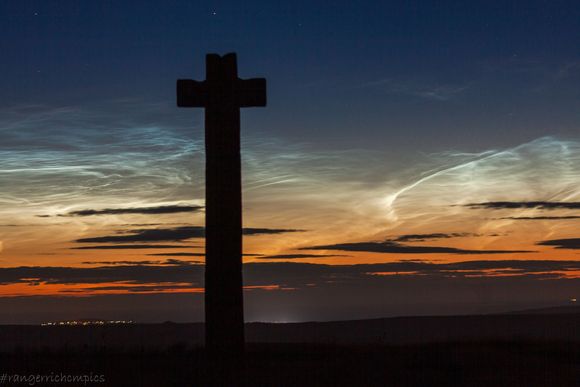
Noctilucent cloud - July 2020. Image Richard Randle from Ralf's Cross.
Given all the fine nights we have enjoyed throughout much of June, you would have thought the chances of catching a display of noctilucent cloud to be quite high as the NCL season reaches a peak. It must be said that sightings have been disappointingly elusive, and as of late June there has been little to report. Any sightings have been very low to the north horizon post-midnight, John Randles at Westerdale saw a minor display around the solstice period, but wasn't sure on the exact date. The NCL season normally draws to a close by the end of July, so there is still time to witness a display. Remain vigilante!
July Night Sky
Nights in early July are just as light as those of mid-June and it's not until the very end of the month before evenings start to darken again. For those not accustomed to the summer night sky, it can still be puzzling identifying many of the constellations pre-midnight. Here, the brighter summer stars come to the rescue, acting as stellar 'signposts' as dusk falls. Brightest of our summer luminaries, Arcturus, can be located high in the SSW in the constellation of Bootes, the Herdsman. At just 37 light years Arcturus is the nearest 'orange giant' star and distinctly orange-yellow in hue. Once a star not dissimilar to our Sun, Arcturus has reached the evolutionary stage of converting Helium at its core, a process lasting another 300 million years,
In comparison, the almost equally brilliant Vega, found overhead to the east, appears still in the flush of youth, its steely blue lustre an apparent indication of this. Vega, is though double the Sun's mass and already halfway through its life. It too will become a giant star ending its days as a Planetary nebula. Vega is the brightest member of the 'summer triangle', an asterism of three stars including Altair and Deneb, first christened by Sir Patrick Moore in 1957. One of the few popular Chinese tales associated with the night sky absorbed into western culture involves Vega and Altair; the imperial weaver girl and the lowly goat herder. After falling in love, they neglected their duties and so to prevent further interruption to their work the celestial emperor harshly separated them, placing them on opposite sides of the Milky Way. Thereafter, the couple were allowed only to meet one night each summer, the seventh night after the seventh full moon, when magpies bridged the Milky Way with their wings.
By 23:30hrs, the familiar ‘saucepan’ outline of the Plough, part of Ursa Major - the Great Bear, emerges from her twighlight den. Utilise the 'pointer stars', Dubhe and Merak, in the 'bowl' of the Plough to locate the pole star - Polaris, found due N just over halfway up. Many 'non astronomers' mistake the bright star low to N horizon at this time of year for the North Star. Capella is a winter luminary in the circumpolar constellation of Auriga - the Herdsman and after Arcturus and Vega is the 3rd brightest star visible during the summer months.
Below and right of Polaris - midway up from the NNE horizon, the rather faint 'crooked house' outline of King Cepheus holds court. His wife, the much more distinct Queen Cassiopeia already visible. Often called the “W” constellation, Cassiopeia contains no bright stars; however, their obvious arrangement does catch the eye. When skies are fully darkened it's well worth spending time exploring Cassiopeia with optical, the constellation containing numerous star fields and clusters. Below Cassiopeia, extending up from the NNE horizon is the great hero Perseus, the pattern of which reminds a little of a distorted Pi symbol reaching up toward Cassiopeia. The Queens sacrificial daughter - Princess Andromeda, along with the winged horse, Pegasus, accompany Perseus on his journey into the NE sky.
Returning to Arcturus, look for the delicate circlet of stars marking Corona Borealis - the Northern Crown, located upper left of Boötes. The reasonably conspicuous star Alphecca or Gemma, sits midway in the starry circlet. To the left of Corona and high to the South, stands a great hero of mythology, Hercules, a large but ill-defined group. The central asterism of Hercules, known as the 'keystone', resembles the shape of the central stone of an arch. On the right-hand side confine of the Keystone resides the wonderful deep sky object M13 - the great globular star cluster, visible in binoculars as a blurred star, but revealed through modest scopes as a glowing gossamer ball. The cluster contains upwards of half a million stars and is 26,000 light years distant. Above Hercules, the head of Draco stands almost overhead, the dragon's body winding down between the two celestial bears.
Much of the West and SW aspect is occupied by constellations associated with spring, some of which are already departing - including Cancer, Leo, and much of Hydra. Very low in the SSW even Spica in Virgo will be on the verge of descending back into the underworld by the month's end. The huge sprawling shape of Ophiuchus occupies much of the sky between Hercules and the S horizon, although none of its stars are particularly prominent. Just visible above the SSW horizon is the bright fiery hue of Antares, chief star in the constellation of Scorpius, which unfortunately only partly rises from the UK. Following the Scorpion across the S horizon, Sagittarius is best identified by the ‘Teapot’ asterism, sitting almost on the horizon. Located in this direction, on the border between these two constellations amidst the celebrated star clouds of the Milky Way, lies the centre of our galaxy – 27,000 light years away.
Returning to the 'summer triangle', the most southerly member of the trio, and the only member to set from the UK is Altair in Aquila the Eagle. You can locate it midway up in the SE. Altair is the nearest of the bright summer luminaries visible from UK shores, a mere 16 light years away. East of Vega, the third and least brilliant member of the 'summer triangle' is, Deneb, in the constellation of Cygnus. Deneb is by far the most distant of the top 20 brightest stars in the sky, at least 1700 light years away, and masks its true luminosity, probably exceeding 150,000 times the Sun's. Such power comes with a price, a short lifespan of no more than 12-15 million years, at the end of which, Deneb will go supernova and for 3 months or so will become a startling visitor to both night and day skies!
July Sky Charts.
Additional Image Credits:
- Planets and Comets where not otherwise mentioned: NASA
- Sky Charts: Stellarium Software and Starry Night Pro Plus 8
- Log in to post comments


